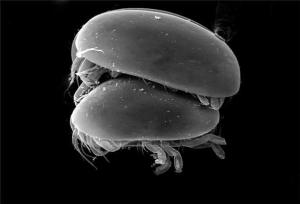
Invader of the Invader: Tiny Crustaceans Found On Red Swamp Crayfish
September 11, 2012
 Two adults (male above) of Ankylocythere sinuosa in the mating position
under a scanning electron microscope. (Credit: Josep A. Aguilar Alberola)
Two adults (male above) of Ankylocythere sinuosa in the mating position
under a scanning electron microscope. (Credit: Josep A. Aguilar Alberola)
ScienceDaily (Sep. 11, 2012) ? The small ostracod Ankylocythere sinuosa measures no more than half a millimetre in length and lives on other crayfish. And, Spanish scientists have discovered it for the first time in Europe. The finding suggests that it arrived along with the invader crayfish Procambarus clarkii some 30 years ago but it is still unknown whether it can invade other
crustacean species or whether it benefits or damages the expansion of the
already established red swamp crayfish.
The red swamp crayfish (Procambarus clarkii) originates from the USA and Mexico and has been present in the Iberian Peninsula since the 1970's. Its expansion is currently on the up. However, its 'invasion' is coupled with that of another species: the ostracod Ankylocythere sinuosa, which is also from North America and totally relies on the crayfish to survive. It has now been discovered in Europe but could have come at the same time as its host 30 years ago.
Published in the Hydrobiologia journal, the study aimed to verify how the Ankylocythere sinuosa arrived on the European Continent. According to researchers, although it has taken more than three decades to discover, "it is certain that it arrived with Procambarus clarkii."
"Ankylocythere sinuosa is common and abundant wherever there is the red swamp crayfish in Europe," as explained by Francesc Mesquita Joanes, lead author of the study and researcher at the Department of Microbiology and Ecology of the University of Valencia.
This minute epibiont crustacean lives on top of its host meaning it cannot live without the crayfish. It lays its eggs on the crayfish and clings on while it develops. The majority of crayfish are infected and "adult specimens can have up to many hundreds of ostracods on them," reveals Mesquita.
Hundreds of tiny crabs on the back of a crayfish
Between 2003 and 2009, the team of researchers took 203 red swamp crayfish from 12 different regions of the Iberian Peninsula from Donana in the southwest to Catalonia in the northeast. In total, 147 of them had ostracods, which were present in practically all sampled regions.
Through comparison with the crayfish living on the USA, the scientists have also discovered that Procambarus clarkii travelled with just this small crustacean on its back. The biologist outlines that "the crayfish did not transport all the possible epibionts present in its place of origin. Although P. clarkii could be infected with other epibiont ostracods in North America, it only brought with it one species to Europe."
The scarce diversity of these crustaceans could help its greater expansion in invaded areas. "We have to remember that these epibionts could spread to other native species," warns Mesquita-Joanes, outlining that it is necessary to study if the ostracod have any sort of effect on Aphanomyces, the plague of crayfish that is causing the extinction of native species.
An invasion for better or for worse
But, what does the presence of Ankylocythere sinuosa in crayfish mean?. The scientists are still unsure. For now, "they seem to basically be just guests and do neither good nor bad to the crayfish. But this is debatable," says the expert to SINC.
For the researcher, the ostracods could do good if they 'clean' parasites or organic material in contaminated areas or they could do harm if they feed off any part of the crayfish or the eggs of the female.
Awaiting new studies that confirm the effects of this relationship, the authors suggest that the ostracod could also spread to other invading or native crayfish, but the results are not very specific and there could be still unknown effects.